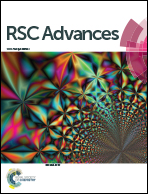Fine-tuning of the hydrophobicity of caffeic acid: studies on the antimicrobial activity against Staphylococcus aureus and Escherichia coli
Abstract
The increased bacterial multidrug resistance caused by inappropriate use and overuse of antimicrobials is a global concern. To circumvent this issue, a quest for the development of new active agents has been widely recognized. Some phytochemical products, produced by plants as part of their chemical defense strategies, are regarded as new stimulii to develop novel antimicrobials that are not as vulnerable as current drugs to bacterial resistance mechanisms. In this study, the antimicrobial activity and mode of action of caffeic acid (CAF) and a series of CAF alkyl esters was assessed against Escherichia coli and Staphylococcus aureus, with the aim of analyzing the influence of the alkyl ester side chain length on the activity. Minimum inhibitory concentration (MIC), minimum bactericidal concentration (MBC), changes in physicochemical surface properties and intracellular potassium leakage were used as physiological indices for the antimicrobial mode of action. CAF alkyl esters were found to be effective antimicrobial agents against both bacteria. Their activity was directly dependent on their lipophilicity, which affected bacterial susceptibility, the physicochemical properties of the bacteria and the integrity of the membranes. E. coli was less susceptible than S. aureus to the action of the compounds. Longer alkyl side chains were more effective against the Gram-positive bacterium, while medium length alkyl side chain compounds were more effective against the Gram-negative bacterium. Caffeic acid derivatives are proposed to act as cell permeabilizers, inducing membrane alterations, causing rupture with potassium leakage, particularly on the Gram positive bacterium, and consequent cell death.


 Please wait while we load your content...
Please wait while we load your content...